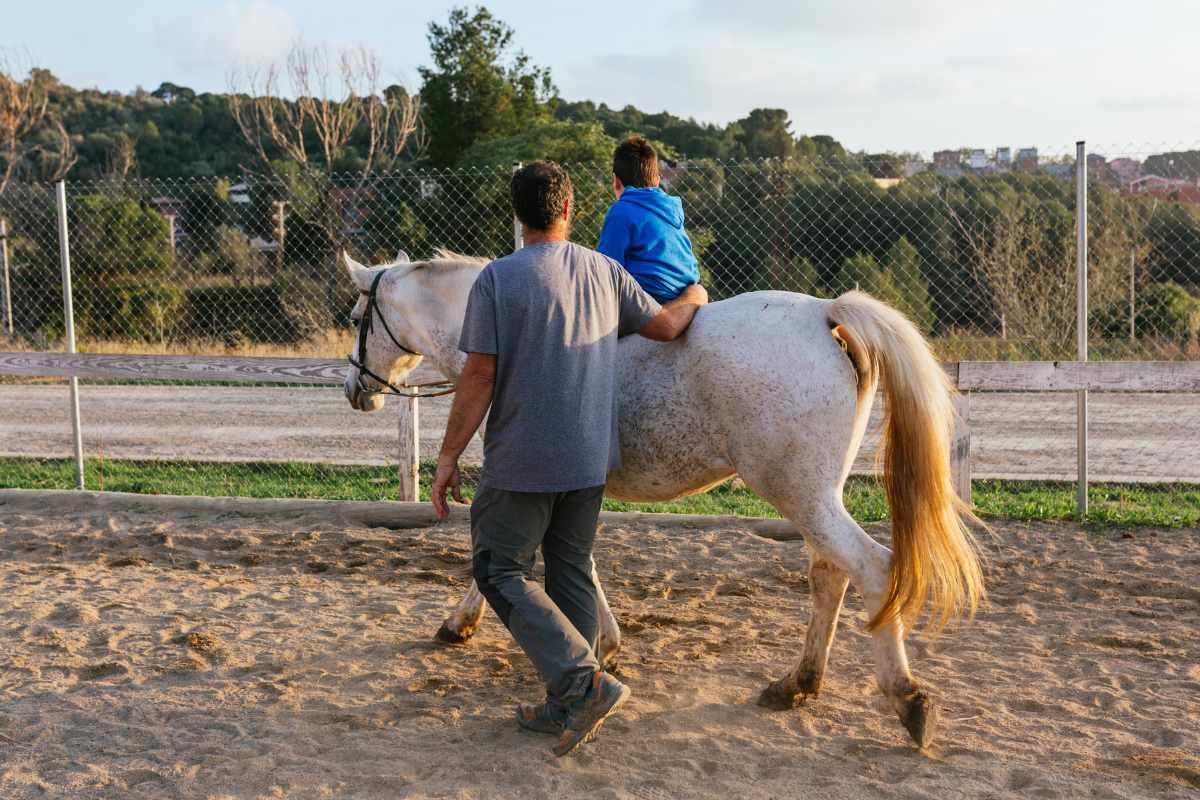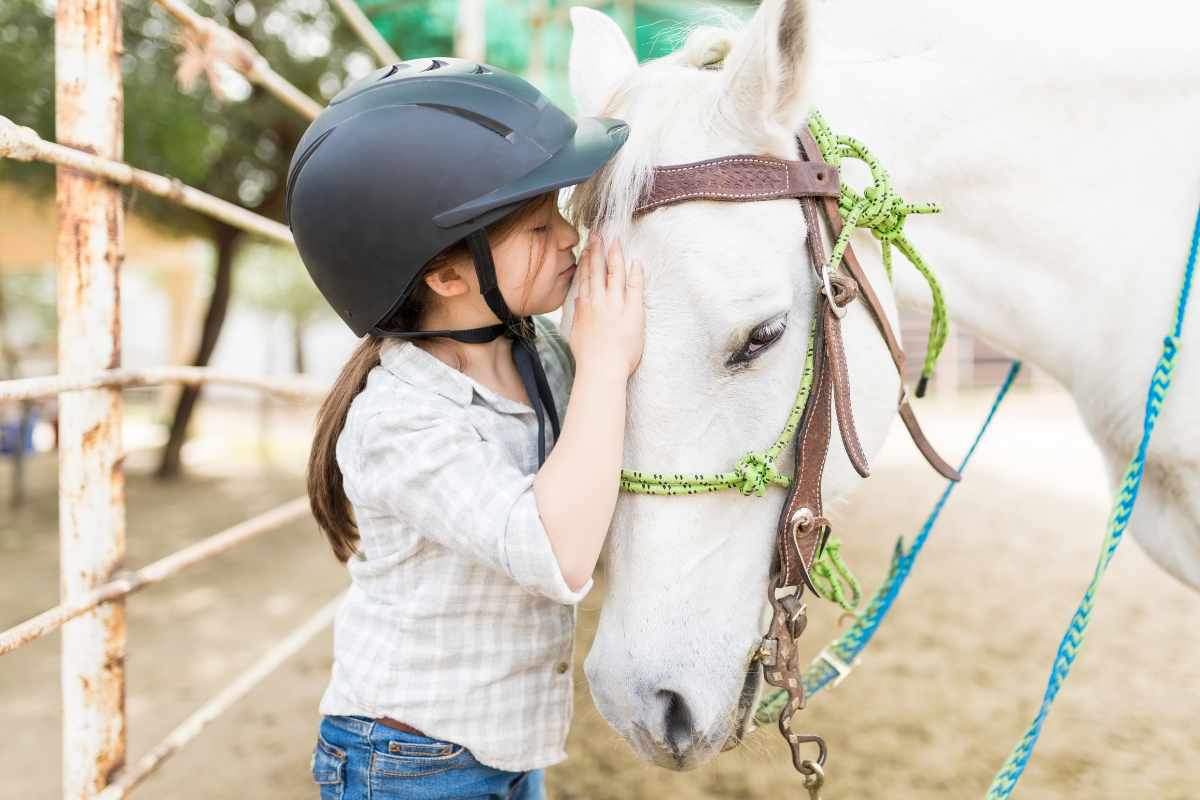- Urbaki Pets
- Horses
- The Unique Bond Between Horses and Humans: A Look at Equine Therapy
The Unique Bond Between Horses and Humans: A Look at Equine Therapy
14/09/2024 · Updated on: 16/10/2025

Equine-assisted therapy is an umbrella for structured, goal-oriented interactions with horses that support physical, cognitive, and emotional well-being.
Many providers group these approaches as Equine-Assisted Services (EAS). The most common formats are hippotherapy, equine-assisted psychotherapy (EAP), and therapeutic riding.
Knowing the differences helps families choose a safe, effective program that fits their goals.
Hippotherapy (Led by OT/PT/SLP)
In hippotherapy, licensed occupational therapists, physical therapists, or speech-language pathologists use the horse’s movement as a treatment tool.
The horse provides rhythmic, three-dimensional motion that can help with postural control, balance, coordination, breath support, and sensory integration.
Sessions are carefully structured—therapists change positions, speed, and direction to deliver the exact input a client needs, often pairing movement with fine-motor or communication tasks.
Equine-Assisted Psychotherapy (EAP)

Equine-assisted psychotherapy is delivered by a licensed mental health professional working with an equine specialist.
Most activities are on the ground—grooming, leading, or problem-solving with the horse—to address emotional regulation, anxiety, trauma processing, boundaries, and communication.
Tasks become real-time metaphors for life: how we ask for space, tolerate frustration, or collaborate under pressure.
Therapeutic Riding
Therapeutic riding focuses on learning to ride in a highly supported setting. Instructors with specialized certifications teach skills that build confidence, independence, social interaction, and fitness.
While riders can experience meaningful benefits, therapeutic riding is not a clinical treatment unless it is explicitly integrated into a plan overseen by a licensed healthcare provider.
What the Research Suggests

The evidence base for EAS is promising yet mixed, varying by condition and study design.
A balanced view: equine-assisted approaches can help some individuals meet functional, behavioral, or emotional goals, especially when used alongside standard care.
Autism Spectrum Disorder (ASD)
Research on ASD commonly reports improvements in social engagement, communication, and behavior regulation following equine-assisted interventions.
Studies often involve small samples and diverse protocols, so results should be interpreted with care.
Still, many families and clinicians find that structured, horse-centered activities can unlock motivation and carry over into home and school routines.
Cerebral Palsy and Motor Outcomes
For children with cerebral palsy, hippotherapy has been associated with better trunk control, balance, and functional mobility in some trials.
The clinical rationale is strong: the horse’s adjustable movement challenges core stability and gait-related abilities in a way that is engaging and repeatable.
Evidence quality varies, so programs should set concrete, measurable goals and reassess progress regularly.
PTSD, Anxiety, and Mood
In post-traumatic stress, anxiety, and depression, EAP shows encouraging but variable outcomes.
Clients often report a calming effect, increased mindfulness, and more effective distress tolerance during challenging tasks.
Most experts view EAP as a useful adjunct to evidence-based mental health treatments when provided by qualified clinicians and aligned with a clear plan of care.
Safety, Screening, and Contraindications

A strong program puts safety first. Before anyone mounts or handles a horse, reputable centers complete a medical and functional screening to match activities with the participant’s needs.
Helmets and Equipment
Mounted activities require a properly fitted, ASTM/SEI-certified riding helmet. Staff should demonstrate correct fit: the helmet sits level, the chinstrap is snug, and it does not rock or slip.
Adaptive tack, mounting ramps, or lifts may be used to maintain dignity and safety during transitions.
Common Contraindications
Some conditions make mounted or close horse interaction unsafe without medical clearance. Typical precautions and contraindications include:
Unstable spine or severe osteoporosis (higher fracture risk with movement).
Uncontrolled seizures, which can endanger participant and support team.
Atlanto-axial instability (possible in Down syndrome) without appropriate clearance.
Open wounds, active infections, or conditions aggravated by dust or dander.
High fall risk without adequate supports or adaptive equipment.
When unsure, request a physician’s note to tailor activities—mounted, unmounted, or alternative tasks that still deliver therapeutic value.
Who Benefits—and How to Set Realistic Goals

EAS suits people who respond to experiential learning, benefit from multi-sensory input, or are motivated by meaningful, novel tasks rather than clinic drills. The keys to success are clarity and realism:
Treat EAS as a complement, not a replacement, for standard care.
Create specific, measurable, attainable goals (e.g., “maintain midline sitting for 5 minutes,” “use three-word requests in two settings,” “complete grooming with one prompt”).
Review progress at planned intervals and adjust the plan based on what actually changes in daily life.
Choosing a High-Quality Program
Use this quick checklist when vetting providers:
Service clarity: Is it hippotherapy, EAP, or therapeutic riding?
Credentials: Hippotherapy must be led by a licensed OT/PT/SLP; EAP by a licensed mental health professional with an equine specialist.
Safety protocols: Consistent helmet policy, trained side-walkers or spotters, emergency procedures, appropriate horse selection and conditioning.
Structured intake: Programs gather medical history, define functional goals, and explain how progress will be measured.
Facility standards: Clean arenas, safe footing, sturdy fencing, and well-cared-for horses receiving regular veterinary, dental, and farrier care.
What a Session Looks Like

Hippotherapy Flow
Sessions typically start with a warm-up to assess trunk stability and breath control, then progress to varied patterns or gaits to challenge balance.
Therapists may integrate reaching, visual-motor, or speech tasks to pair movement with functional goals. A cool-down reinforces regulation and body awareness before dismounting.
EAP Flow
Activities are ground-based—grooming, leading through obstacles, or solving a team task.
The therapist observes attunement, boundaries, and communication, then facilitates a debrief that connects patterns with work, school, or relationships. Small, actionable goals are set for the week.
Therapeutic Riding Flow
Riders learn mounting, steering, stopping, and transitions, gradually adding patterns or small obstacles. The emphasis is on confidence, independence, fitness, and social interaction—all within a supportive, skills-first lesson.
Tracking Progress You Can See

Make outcomes visible with simple measures that match your goals:
Motor: seconds maintaining midline sitting, assistance level for mounting, distance ridden with independent balance.
Speech/Language: frequency of spontaneous requests, length of utterances, accuracy following two-step directions.
Behavioral/Emotional: number of smooth transitions, time to self-regulate, ability to state needs using assertive language.
Review every 6–12 sessions. Keep what works, modify what doesn’t, and consider mixing mounted, unmounted, and home activities to sustain momentum.
Costs, Access, and Insurance

Fees vary by region and service. Therapeutic riding is commonly out-of-pocket. Hippotherapy may be billed under occupational, physical, or speech therapy when payer policies allow and documentation supports medical necessity.
EAP is sometimes reimbursable under mental health benefits when delivered by a licensed clinician. Ask providers to clarify billing codes, documentation, and letters of medical necessity they can supply.
Ethical Care and Horse Welfare
Excellent programs safeguard people and horses. Look for tack that fits, appropriate workloads, scheduled rest days, and training that rewards calm, willing behavior.
If a horse shows discomfort or fatigue, staff should pause or modify the session. Protecting horse welfare is not just ethical—it’s a core safety practice.
Getting Started: A Simple Roadmap

Consult your current provider to confirm that EAS aligns with your goals.
Choose the right service—hippotherapy, EAP, or therapeutic riding—and verify credentials.
Schedule a thorough intake to set clear, measurable objectives.
Begin with a trial block (for example, 6–8 sessions) and track outcomes that matter at home, school, or work.
Review and refine the plan, integrating brief home practices to reinforce gains.
A Hopeful Takeaway

Equine-assisted therapy can open real-world doors—steadier steps, calmer minds, clearer voices, and stronger confidence.
Results are most meaningful when services are credentialed, goal-driven, and integrated with the rest of a person’s care.
Approach the barn with curiosity and clear expectations, and you’ll be better positioned to see changes that matter in everyday life.
Enjoy The Video About Equine Therapy

Source: Priory

Urbaki Editorial Team is the collaborative byline behind our pet-care guides. Our writers and editors turn evidence and real-life experience into clear, humane advice on training, wellbeing, nutrition basics, and everyday life with animals. Every article is planned, written, and edited by humans, fact-checked against reputable veterinary sources, and updated over time. This is an editorial pen name—see our Editorial Policy. Educational only; not a substitute for veterinary advice.

You may also like